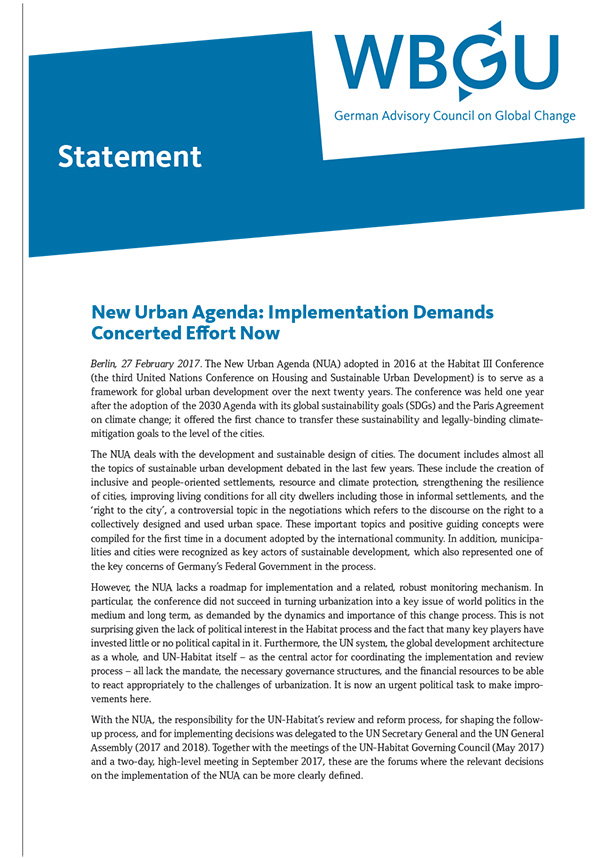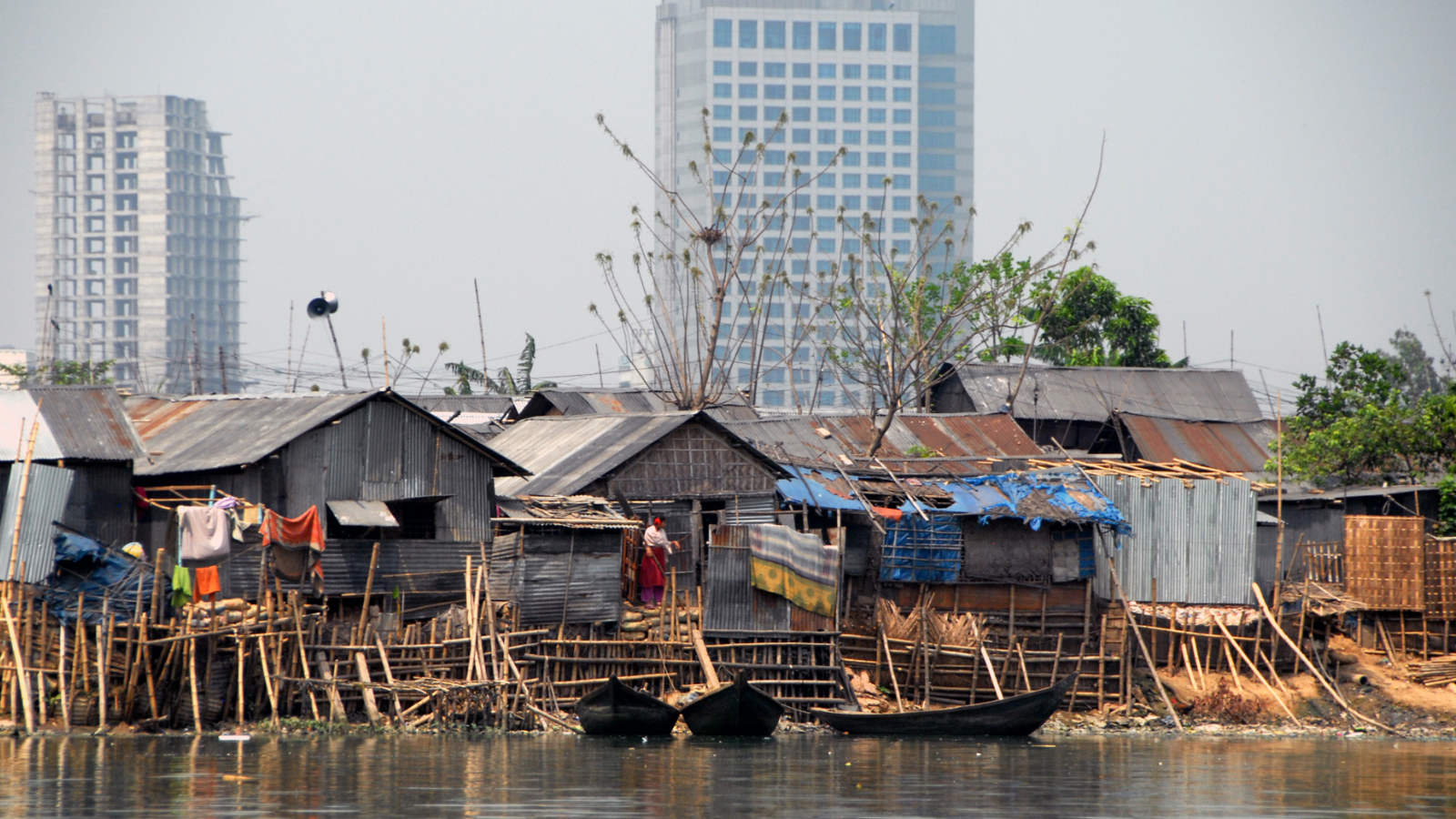
New Urban Agenda: Implementation Demands Concerted Effort Now

The New Urban Agenda (NUA) adopted in 2016 at the Habitat III Conference (the third United Nations Conference on Housing and Sustainable Urban Development) is to serve as a framework for global urban development over the next twenty years. The conference offered the first chance to transfer these sustainability and legally- binding climatemitigation goals to the level of the cities.
Overview
The NUA deals with the development and sustainable design of cities. The document includes almost all the topics of sustainable urban development debated in the last few years. These include the creation of inclusive and people-oriented settlements, resource and climate protection, strengthening the resilience of cities, improving living conditions for all city dwellers including those in informal settlements, and the ‘right to the city’, a controversial topic in the negotiations which refers to the discourse on the right to a collectively designed and used urban space. These important topics and positive guiding concepts were compiled for the first time in a document adopted by the international community. In addition, municipalities and cities were recognized as key actors of sustainable development, which also represented one of the key concerns of Germany’s Federal Government in the process.
However, the NUA lacks a roadmap for implementation and a related, robust monitoring mechanism. In particular, the conference did not succeed in turning urbanization into a key issue of world politics in the medium and long term, as demanded by the dynamics and importance of this change process. This is not surprising given the lack of political interest in the Habitat process and the fact that many key players have invested little or no political capital in it. Furthermore, the UN system, the global development architecture as a whole, and UN-Habitat itself – as the central actor for coordinating the implementation and review process – all lack the mandate, the necessary governance structures, and the financial resources to be able to react appropriately to the challenges of urbanization. It is now an urgent political task to make improvements here.
With the NUA, the responsibility for the UN-Habitat’s review and reform process, for shaping the followup process, and for implementing decisions was delegated to the UN Secretary General and the UN General Assembly (2017 and 2018). Together with the meetings of the UN-Habitat Governing Council (May 2017) and a two-day, high-level meeting in September 2017, these are the forums where the relevant decisions on the implementation of the NUA can be more clearly defined.
More about this topic
It will be decided in cities whether sustainability succeeds or not
It will be decided in cities whether the transformation towards sustainability succeeds worldwide or not. Together with the issue of climate change, the transformation of cities towards sustainability should be right at the top of the agendas at the United Nations, the G7, the G20, the development banks and in bilateral cooperation. If this does not happen, it will be impossible to meet the global sustainability goals.
- There is very little time left to make the huge, ongoing worldwide urbanization process sustainable. The measures taken and investments made over the next three decades will create huge path dependencies for the future. They will either set the world on a future-proof course, or perpetuate erroneous, perhaps unrectifiable developments for the whole world. Worldwide urban development must take its orientation both from the Paris Agreement and from the 2030 Agenda with its 17 SDGs; otherwise these goals cannot be achieved. Against this background, the WBGU would like to highlight as especially relevant the following aspects that already form an integral part of the NUA: Urban development can only succeed if the planetary guardrails are complied with. All fossil sources of CO2 emissions in cities should be replaced by emissions-free alternatives – and transport systems completely decarbonized – by the middle of the century or by 2070 at the latest. Sustainable urban development requires the use of environment- and climate-friendly building materials, because steel, cement and concrete are among the drivers of global warming. In addition, a circular economy that is as complete as possible should be established in this century.
- The urban space should be shaped primarily by the people who live there. People-oriented cities can only evolve if the social, economic and political inclusion of the urban population is guaranteed. A prerequisite for this is an urban development policy committed to the concept of collaborative governance and access to basic services, e.g. through the creation of inclusive mobility systems and affordable housing. Implementation partnerships can make an important contribution here.
- Urban quality of life depends on the Eigenart, i.e. the specific character, of cities. Historically evolved urbanity and creative spaces generate identity; public places and spaces make exchange and a sense of community possible; architecture can express and encourage beauty, openness, humaneness and creativity instead of exclusion. Eigenart can only develop if citizens can participate in the shaping of their cities.
- Polycentric structures improve the quality of life in cities; they create social permeability and cultural diversity, and prevent the displacement of population groups to urban and regional peripheries. In addition, bringing more life into small and medium-sized cities can reduce rural-urban disparities. Digitization, renewable energies and a circular economy can lay the foundations for polycentric urban landscapes; innovations in infrastructure and technology can support polycentric urban models.
- For these tasks, a polycentric responsibility architecture is necessary. Cities should be integrated into state structures in such a way that they can regulate their local affairs themselves following the principle of subsidiarity, and are provided with the necessary financial resources (decentralization) or given access to sources of finance to be able to meet the enormous investment required. Furthermore, the exchange of ideas and information in and across the various levels of governance (local-regional-national-international) must be improved by means of vertical and horizontal coordination and cooperation mechanisms.
The New Urban Agenda lacks clear objectives and a roadmap for implementation
The Habitat III process did not manage to create the political momentum to do justice to the impetus, speed, diversity and global importance of urbanization and thus to the outstanding role of cities in global sustainability. There is a lack of the stringency and radicalism necessary for a serious, politically desirable paradigm shift towards sustainability. In particular, the NUA lacks concrete agreements and clear time frames for a successful step-by-step implementation of the goals. Although the NUA takes up the 2015 Paris Agreement and reiterates the goal adopted there of limiting global warming to well below 2°C, it neither states that this will have a massive impact on cities and their future development, nor does it develop approaches to implementing the climate target. Because of its vagueness, the NUA thus falls behind many international agreements when it comes to environment and climate protection. The 20-year-old negotiating cycle of the Habitat Conferences was confirmed in Quito – a rhythm that is far too long to credibly tackle the urgent need for action over the coming years and to develop suitable, coordinated action guidelines and steps for implementation.
Link the New Urban Agenda better with the climate-change and sustainability agenda
It was agreed in Quito that the design of the NUA review process should be completed and decisions made on the reform of the UN-Habitat programme within two years, i.e. by autumn 2018. The implementation of the NUA is also linked to the 2030 Agenda process (e.g. with SDG no. 11: ‚Make cities and human settlements inclusive, safe, resilient and sustainable’), to the Paris Agreement and to the Sendai Framework for Disaster Risk Reduction – albeit only in a fragmentary manner to date. At least the four-year rhythm of the NUA reporting process is geared towards the High-level Political Forum on Sustainable Development (HLPF). The report is to be integrated into the HLPF process via the United Nations Economic and Social Council (ECOSOC). UN-Habitat is also responsible for reporting on SDG no. 11. It should be a key concern in the negotiations to link the NUA review process even more closely with those of the 2030 Agenda and the Paris Agreement.
The HLPF will be in the political spotlight for the next 15 years. This should also be used to benefit the NUA, especially since urban actors are involved in the implementation of virtually all SDGs. Many indicators already exist and need not be newly developed for the NUA, just broken down or adapted to the city level. In this context, the primary objective should be a review of development trends in the key transformative action fields, i.e. those areas of urban development that are central for a transformation towards sustainability.
The Paris Agreement and the 2030 Agenda involve extensive reporting obligations. Robustly anchored obligations should also be agreed for the NUA. Action here should be oriented as far as possible towards indicators from the other processes so as not to overwhelm the states and cities with reporting obligations.
Make urbanization a key issue of world politics
Despite the huge importance of the urbanization process for the success of the Great Transformation towards sustainability, sustainable urban development has not given the appropriate priority by global politics up to now. The WBGU recommends:
- greatly shortening the cycle of the Habitat Conference, preferably to four years – knowing full well that realistically this is not very likely at present. The current conference cycle of 20 years belies the pressure to act generated by the momentum of global urbanization dynamics.
- strengthening UN-Habitat while also further expanding and improving networking and cooperation within the UN system. The reform should aim to make UN-Habitat as a first step an assertive and effective institution whose influence and efficacy are at least on a par with the United Nations Environment Programme (UNEP). To achieve this, a new, more effective and transparent management structure should be created (inter alia by setting up an executive board that makes swift decisions possible). Furthermore, UN-Habitat should set up a scientific department and appoint a chief scientific advisor. In the medium term, UN-Habitat should be upgraded to a UN specialized agency. In addition to giving it greater weight and more independence, this opens up the possibility of granting cities or city networks a bigger say – like the structures of the International Labour Organization, in which representatives of employers and employees participate. Closer cooperation between UN-Habitat and other UN organizations would also make it easier to bring the urban perspective into the processes of implementing the central agendas of the global sustainability goals and climate-change mitigation.
- introducing scientific expertise on urbanization in a structured form into the United Nations. Regular assessment reports are particularly suitable for this purpose. They should be compiled either by the World Urban Forum or by a new panel of urbanization experts.
- strengthening cities as (independent) actors by enabling local governments to take on an active role in the formulation and implementation of national development strategies, and to upgrade their role as actors in the UN system, for example by giving them the right to participate in and speak at all UN negotiations with urban relevance.
- making urbanization a topic to which appropriate attention is paid across sectors in the bi- and multilateral development organizations, for example by drafting and implementing new approaches to integrated urban development, expanding existing (sectoral) priorities and activities in urban areas, the targeted financing of urban development, or laying down general objectives for contributions to sustainable urban development. Up to now, urbanization has not only been a marginal issue of world politics, but also a neglected area of international development cooperation.
In the forthcoming negotiations, Germany’s Federal Government should vigorously promote an implementation of the New Urban Agenda with clear objectives and time frames, as well as a reformed UN-Habitat that is equal to the challenges.
